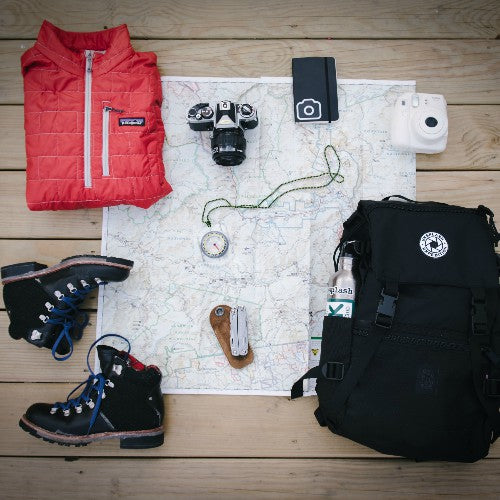

· By Amanda Stelter
What To Bring On A Hike
There's no denying nature has a way of bringing us back down to earth and grounding us. Walking beneath trees towering high above, alongside quiet rivers carving their way through the forest, up mountains that test our strength, nature is a safe place for many of us. It's all fun times and laughter until one realizes they've forgotten, or didn't even think to grab, an essential.
You may not be going on a strenuous multiday backpacking trek, but it's just as important to prepare for your day hike as if you are! After many day hiking trips of our own, we've become professionals at keeping our packs light by only packing the absolute essentials. Everyone's terms for "essential" differ slightly, so feel free to use ours as a template when figuring out your own. Without further ado, here are our 5 day trip hiking essentials.
...

1. Water
First and most obvious, water! It can be hard to know exactly how much bring along. Water intake will vary depending on a person's height and weight, the temperature outside, and the difficulty of the hike. A good rule of thumb is 1 liter for every two hours spent hiking. The image below is another resource to use when preparing for your day hike. Overall, it's best to be overprepared (to a certain extent, you definitely don't want to unnecessarily weigh down your pack) than underprepared when in unfamiliar territory and in case of emergencies.

...

2. Trail Snacks
The last thing you want while being out and about on the trails is to have your mind fogged with dreams of food, and miss out on the views and experience. Not all snacks are created equal; sure, packaged and processed snacks are convenient, but they're not gonna leave your body feeling its best. We created a whole article outlining some of our favorite snacks to bring with us on the trails that are both delicious and nutritious, click here for the full scoop. We believe your nutrition shouldn't be sacrificed for the sake of adventure!
...

3. A Trail Map
We don't know a single person that wants to get lost on the trail; mentally sure, but not physically. We've come a long way from the paper trail maps explorers carried around, and while those will always remain a great resource, technology is just as handy.
GPS trackers are a great resource to have when hitting trails in any unfamiliar territory. They provide a sense of ease while on the trail by assuring you'll know where you are at all times in relation to the trail. Although we hit the trails to get away from the world, we can't deny that our phones are a great resource as well. If you don't have a GPS tracker, fear not, apps like maps.me and AllTrails allow you to view your location on and off the trail without service. Even when these maps fall short, stay true to your gut, evaluate your surroundings, and keep calm!
...

4. Hiking Boots / Comfortable Shoes
A more controversial topic than you would think, hiking shoes. There are people who love the sturdy ankle boot, those who swear by universal trail runners, and those who have hiked mountains in a decent pair of tennis shoes. At the end of the day, we're not here to tell people what's best for them, we can only tell you to do your research and test out multiple fits until you find what works best for you!
t's important to consider a couple things when you're choosing hiking shoes such as the type of terrain you're walking, weather conditions, the difficulty of the hike, and, of course, your own personal body type. With all of these factors in mind, you can make a better decision of the type of shoe that's most comfortable for you. Footwear is a crucial consideration because nobody wants to be in pain during a time when they should be stoked to explore.
...

5. Weather-appropriate Clothing
Dress for the weather is never more serious than when you're immersing yourself into nature where the weather is inescapable. Whether you're going out in sunny, rainy, or snowy conditions, dressing for the part is a crucial step to keeping your body safe and protected. Gauge your clothing according to the weather conditions and the distance of the hike to gain a well-rounded estimate of how long you'll be exposed, then dress accordingly. The same goes with footwear, snowy conditions will require spikes or snowshoes of some sort, so keep every aspect of clothing in mind!
...

6. Accessory Items
Accessories don't just include gear, but also sunscreen, bug spray, sunglasses, hats, and other items you might need to help you adapt to the environment you're immersing yourself in. Other items to include in your pack include your camera if you're wanting to capture stunning photos of your journey along the way, a journal if you're hitting the trails to get lost in your thoughts, and other small items that will make the experience more enjoyable for you. These items are necessary by any means, but consider whether or not their worth the extra weight and choose accordingly.
...
There you have it, our top essentials to bring when hitting the trails. We hope this provides you with some clarity and helps make packing for your next trip easy as pie. Let us know what your essentials are in the comments, we'd love to know!
